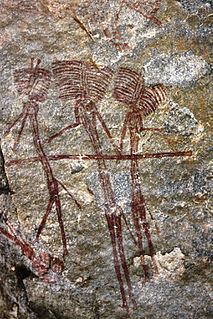The African Great Lakes nation of Tanzania dates formally from 1964, when it was formed out of the union of the much larger mainland territory of Tanganyika and the coastal archipelago of Zanzibar. The former was a colony and part of German East Africa from the 1880s to 1919’s when, under the League of Nations, it became a British mandate. It served as a British military outpost during World War II, providing financial help, munitions, and soldiers. In 1947, Tanganyika became a United Nations Trust Territory under British administration, a status it kept until its independence in 1961. The island of Zanzibar thrived as a trading hub, successively controlled by the Portuguese, the Sultanate of Oman, and then as a British protectorate by the end of the nineteenth century.

In archaeology, rock art is human-made markings placed on natural surfaces, typically vertical stone surfaces. A high proportion of surviving historic and prehistoric rock art is found in caves or partly enclosed rock shelters; this type also may be called cave art or parietal art. A global phenomenon, rock art is found in many culturally diverse regions of the world. It has been produced in many contexts throughout human history. In terms of technique, the main groups are: petroglyphs, which are carved or scratched into the rock surface, cave paintings, and sculpted rock reliefs. Another technique creates geoglyphs that are formed on the ground. The oldest known rock art dates from the Upper Palaeolithic period, having been found in Europe, Australia, Asia, and Africa. Anthropologists studying these artworks believe that they likely had magico-religious significance.

The Ennedi Plateau is located in the northeast of Chad, in the regions of Ennedi-Ouest and Ennedi-Est. It is considered a part of the group of mountains known as the Ennedi Massif found in Chad, which is one of the nine countries that make up the Sahelian belt that spans the Atlantic Ocean to Sudan. The Ennedi is a sandstone bulwark in the middle of the Sahara, which was formed by erosion from wind and temperature. Many people occupied this area, such as hunters and gatherers and pastoralists. The Ennedi area is also known for its large collection of rock art depicting mainly cattle, as these animals served as the main source of financial, environmental, and cultural impact. This art dates back nearly 7,000 years ago. Today, two semi-nomadic groups, mainly of the Muslim religion, have permanent villages in the Ennedi during the rainy months and pass through the area during the dry season. They rely on their herds of camels, donkeys, sheep, and goats to survive.

The Tsodilo Hills are a UNESCO World Heritage Site (WHS), consisting of rock art, rock shelters, depressions, and caves in southern Africa. It gained its WHS listing in 2001 because of its unique religious and spiritual significance to local peoples, as well as its unique record of human settlement over many millennia. UNESCO estimates there are over 4500 rock paintings at the site. The site consists of a few main hills known as the Child Hill, Female Hill, and Male Hill.
The Anglican Church of Tanzania (ACT) is a province of the Anglican Communion based in Dodoma. It consists of 28 dioceses headed by their respective bishops. It seceded from the Province of East Africa in 1970, which it shared with Kenya. The current primate and archbishop is Maimbo Mndolwa, enthroned on 20 May 2018.

Ujamaa was a socialist ideology that formed the basis of Julius Nyerere's social and economic development policies in Tanzania after it gained independence from Britain in 1961.
The Bena are Bantu ethnolinguistic group based in the Njombe Region of south-central Tanzania who speak the Bantu Bena language. In 2001, the Bena population was estimated to number 670,000.

The Rangi are a Bantu and cushitic ethnic groups in the Dodoma Region of central Tanzania. In 2022 the Rangi population was estimated to number 880,000.

The Haya are a Bantu ethnic group based in Kagera Region, northwestern Tanzania, on the western side of Lake Victoria. With over one million people, it is estimated the Haya make up approximately 2% of the population of Tanzania. Historically, the Haya have had a complex kingship-based political system. Agriculture, particularly banana farming, is central to Haya economic life.

The Kondoa Rock-Art Sites or Kondoa Irangi Rock Paintings are a series of ancient paintings on rockshelter walls in central Tanzania. The Kondoa region was declared a UNESCO World Heritage site in 2006 because of its impressive collection of rock art. These sites were named national monuments in 1937 by the Tanzania Antiquities Department. The paintings are located approximately nine kilometres east of the main highway (T5) from Dodoma to Babati, about 20 km north of Kondoa town, in Kondoa District of Dodoma Region, Tanzania. The boundaries of the site are marked by concrete posts. The site is a registered National Historic Sites of Tanzania.

Kondoa District is one of the seven districts of the Dodoma Region of Tanzania. It is bordered to the north by Manyara Region, and to the south by Chemba District. Its district capital is the town of Kondoa.

The Tarangire River is a perennial river located in central Manyara Region in the eastern branch of the East African Rift Valley, within northern Tanzania.
The following is a timeline of the history of Zanzibar City, Unguja island, Zanzibar, Tanzania. The city is composed of Ng'ambo and Stone Town. Until recently it was known as Zanzibar Town.

Mathias E. Mnyampala (1917–1969) was a Tanzanian writer, lawyer, and poet. Mnyampala was born on 18 November according to a personal record form of 1956, but he wrote in his autobiography that he only knew the year with accuracy. He was born in the hamlet of Muntundya depending of the village of Ihumwa in Chamwino District in Dodoma region at the time part of German East Africa. He died on 8 June 1969 in Dodoma city, Tanzania. Mnyampala wrote in Swahili, the lingua franca of East Africa, not Cigogo, the native language of his ethnic group.

Swaga Swaga Game Reserve is a Tanzanian game reserve located in northwest Dodoma Region, that gives refuge to elephants and other vulnerable animals. It is located 50.6 miles from the city of Babati.
The Pan-African Freedom Movement of East and Central Africa (PAFMECA), later renamed the Pan-African Freedom Movement of East, Central and Southern Africa (PAFMECSA) was a political and Pan-Africanist organisation that was formed to campaign for the independence of the countries of East and Central Africa from colonial and white minority rule. The organisation was formed at a conference held in Mwanza, Tanganyika, from 16 to 18 September 1958. Julius Nyerere and Tom Mboya the Kenyan Pan-Africanist and trade unionist were among the founders. Nyerere came up with idea for the conference.
Freedom of religion in Tanzania refers to the extent to which people in Tanzania are freely able to practice their religious beliefs, taking into account both government policies and societal attitudes toward religious groups.
The Ninth German Inner Africa Research Expedition was led by Leo Frobenius to Southern Africa between August 1928 and March 1930. It visited modern-day South Africa, Zimbabwe, Botswana, Lesotho, Mozambique, Namibia and Zambia. It recorded a large quantity of indigenous rock art, which helped Frobenius to build one of the most important collections of such work, some of which was sold to South African museums. It also investigated ancient ore mines and provided samples for some of the first metallographic and chemical analysis of southern African indigenous metals.
Hans CoryOBE was a self-taught British social anthropologist of Austrian descent, farmer and sociologist with a special interest in traditional lifestyles of ethnic groups in former Tanganyika, now Tanzania. Little is known about his childhood and youth in Vienna as well as about his life before the First World War in colonial German East Africa.
National Historic Sites of Tanzania is an official list of places in Tanzania that have been designated as National Historic Sites as per the Ministry of Natural Resources and Tourism of Tanzania under the Antiquities Division. The list is not complete and is currently being updated.











